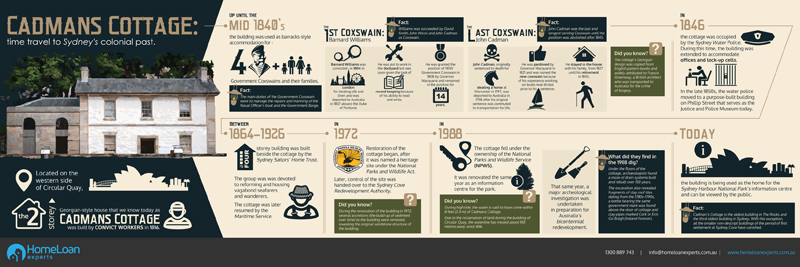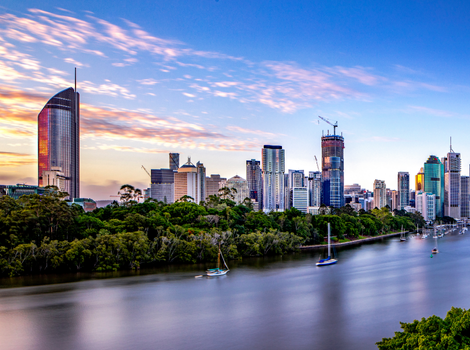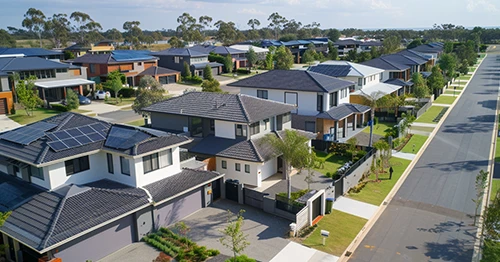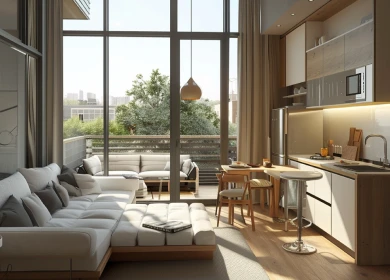Updated: 29 May, 2025

Australia was discovered less than 250 years ago and only became a nation in 1901, making us one of the youngest western nations in the world.
Luckily for us though, our youth means there are still remnants of our colonial past scattered across the country, particularly in Sydney.
The oldest and most-well preserved example of a house from this era is Cadmans Cottage, a two-storey Georgian-style house located on the western side of Circular Quay in Sydney.
Here’s the secret history that you (probably) didn’t know.
Who built Cadmans Cottage?
Commissioned by New South Wales Governor Lachlan Macquarie, the cottage was built by convict workers in 1816 and formed part of the government dockyard at The Rocks at the time. It originally stood on a rocky shore with a small sandy beach.
The cottage design was copied from English pattern books and widely attributed to Francis Greenway, a British architect who was transported to Australia for the crime of forgery. The cottage was designed for ex-convicts so its design is simple and formal rather than ornate or decorative.
The barracks were constructed by cutting into a natural rock shelf.
What was it used for?
The building was used as a barracks-style accommodation for four Government Coxswains (the chief petty officer that commanded the government ships at the dockyard) and their families up until the mid-1840s.
The Government Coxswain’s main duties were to manage the repairs, manning and availability of the Naval Officer’s boat, and to captain the Governors Barge.
Barnard Williams: the first Coxswain
- Barnard Williams was convicted for stealing silk and linen in 1804 in London and was deported to Australia. He arrived in Sydney aboard the Duke of Portland in 1807.
- He was put to work in the dockyard but was soon given the task of record keeping because of his ability to read and write.
- He was granted the position of NSW Government Coxswain in 1808 by Governor Macquarie and remained in the position for 14 years.
- In 1816, Williams found himself in court for the second time against the charge of threatening and abusive language.
- In 1818, he outfitted the crew of the Government Barge with a new suit of clothing funded by the Police Fund.
- In 1821, he was asked to build huts for the native aborigines at what is now Georges Head at Mosman.
- Williams was succeeded as Coxswain by David Smith and John Weiss.
John Cadman: the last Coxswain
- Cadman was initially sentenced to death for stealing a horse at Worcester in 1797, which was later commuted to transportation for life.
- He arrived in Sydney on the Barwell in 1798 and pardoned by Governor Macquarie in 1821.
- Prior to his sentence, he worked on boats near Bristol and, because of his experience, he was named the new Coxswain.
- He had worked under Barnard Williams before his death.
- Cadman married Elizabeth Mortimer in 1830, who is believed to be the first woman in NSW to allowed the vote.
- He stayed in the house with his wife and two stepdaughters, from 1827 until his retirement in 1845.
- Cadman was the longest serving Coxswain until the position was abolished after 1845.
- He was also the last Coxswain to live in the cottage and became the namesake of the building.
1846
By 1846, the cottage was occupied by the Sydney Water Police and the building was soon extended to accommodate offices and lock-up cells.
In the late 1850s, the water police moved to a purpose-built building on Phillip Street that now serves as the Justice and Police Museum.
Between 1864-1926
A four-storey building was built beside the cottage by the Sydney Sailors’ Home Trust, a group that was devoted to reforming and housing vagabond seafarers and wanderers.
The cottage was later resumed by the Maritime Service.
1972
Restoration of the cottage began after it was named a heritage site under the National Parks and Wildlife Act.
During the renovation of the building in 1972, several accretions (the build-up of sediment over time) to the building were removed, revealing the original sandstone structure of the building.
Control of the site was later handed over to the Sydney Cove Redevelopment Authority.
1988
Cadmans Cottage was under the ownership of the National Parks and Wildlife Service by the late 1970s. It was renovated the same year as an information centre for the park.
A major archeological investigation was undertaken in 1988 in preparation for Australia’s bicentennial redevelopment.
What did they find in the 1988 dig?
Under the floors of the cottage, archaeologists found a maze of drain systems built and rebuilt over a period of 150 years.
The drainage system was constantly modified to cope with damp conditions.
The excavation also revealed fragments of clay roof tiles dating from the 1780s-1790s, a bottle bearing the same government mark as the one found above the door of the cottage and clay pipes marked Cork or Erin Go Bragh, meaning ‘Ireland Forever’.
Cadmans Cottage today
Today, the cottage is used as the home for the Sydney Harbour National Parks information centre and can be viewed by the public.
Cadmans Cottage is the oldest building in The Rocks and the third oldest building in Sydney.
It’s survival on the former shoreline of Sydney Cove illustrates the evolution of Circular Quay and the city of Sydney as a whole.
With the exception of Cadmans Cottage, all the smaller non-descript buildings of the period of first settlement at Sydney Cove have vanished.
Really into colonial buildings?
Unfortunately, Cadmans Cottage isn’t up for sale because it’s a historical site. Despite this, there are specialist lenders who will accept heritage-listed properties.
Did you know that even if the property you want to buy isn’t a historical site, certain lenders will not accept certain properties and locations?
Luckily, an experienced mortgage broker can help you build a strong case with the right lender.
If you’re interested in purchasing or refinancing a heritage-listed property or you’re not sure whether your property will be accepted by the bank, call us on 1300 889 743 or complete our free assessment form to find out how we can help you.







